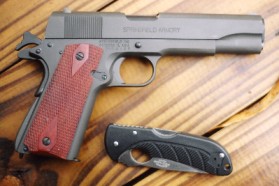 Among our most respected modern makers of 1911 handguns is Springfield Armory. Springfield came into the market at exactly the right time, when Colt had given up the lead in 1911 sales and seemed in danger of giving up altogether. GI .45s suitable for modification or hard use were becoming scarce, and there was really nothing comparable available. Springfield arrived on the scene with the 1911A1, a GI like handgun with many good features. The Springfield is a look alike more so than a copy. The Springfield incorporates a good trigger action and certain improvements over the GI crop such as the ability to feed hollow point ammunition. These improvements are much appreciated. Springfield produces a number of variants on the 1911 theme, including the top of the line Bureau Model and the Loaded Model, a pistol with many good features including Novak sights. But the Mil Spec or 1911 pistol remains very popular.
Among our most respected modern makers of 1911 handguns is Springfield Armory. Springfield came into the market at exactly the right time, when Colt had given up the lead in 1911 sales and seemed in danger of giving up altogether. GI .45s suitable for modification or hard use were becoming scarce, and there was really nothing comparable available. Springfield arrived on the scene with the 1911A1, a GI like handgun with many good features. The Springfield is a look alike more so than a copy. The Springfield incorporates a good trigger action and certain improvements over the GI crop such as the ability to feed hollow point ammunition. These improvements are much appreciated. Springfield produces a number of variants on the 1911 theme, including the top of the line Bureau Model and the Loaded Model, a pistol with many good features including Novak sights. But the Mil Spec or 1911 pistol remains very popular.
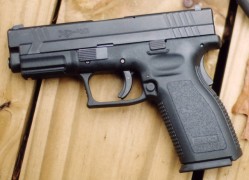 A more recent addition to the Springfield line is the XD 40. The XD 40 began life as the HS 2000, a Croatian effort at a world class pistol. Originally offered in 9mm Luger caliber, and still offered as the XD 9, this handgun has many good features. The pistol appears to be a match up of Glock profile and trigger action, SIG takedown, and the H and K recoil system. But it also features a grip safety and grip angle similar to the 1911 pistol. Unlike the Glock, the XD 40 has a margin of safety when holstering the handgun. If the trigger snags on the holster, the grip safety of the XD 40 will prevent the pistol from firing. This is a laudable addition to the handgun. The XD 40 shows better fit and finish than the original HS 2000 and the pistol is now backed by a respected maker’s warranty. The XD is among the better new generation service handguns in my opinion.
A more recent addition to the Springfield line is the XD 40. The XD 40 began life as the HS 2000, a Croatian effort at a world class pistol. Originally offered in 9mm Luger caliber, and still offered as the XD 9, this handgun has many good features. The pistol appears to be a match up of Glock profile and trigger action, SIG takedown, and the H and K recoil system. But it also features a grip safety and grip angle similar to the 1911 pistol. Unlike the Glock, the XD 40 has a margin of safety when holstering the handgun. If the trigger snags on the holster, the grip safety of the XD 40 will prevent the pistol from firing. This is a laudable addition to the handgun. The XD 40 shows better fit and finish than the original HS 2000 and the pistol is now backed by a respected maker’s warranty. The XD is among the better new generation service handguns in my opinion.
With the ever increasing popularity of these handguns, I felt that a heads up comparison of the two might be illuminating. Sure, they will appeal to different shooters but a hard look at the 1911 and one of the modern ‘safe action’ pistols might give us some insight into the true differences in handling, reliability and accuracy of the two. Those of us who appreciate the 1911 may not purchase an XD 40 and a modern shooter who fancies himself high speed low drag may not give a second look to the 1911, but I think that the mature shooter will realize that either will do the job in good hands.
I have some experience with the XD 40 as well as the XD 9 and a mountain of experience with the 1911. I have owned several Springfield .45s, modified them to Bureau Model standards, and carried the Springfield professionally. I have enjoyed such good service from these handguns for so long I felt it best to purchase a new production Springfield Mil Spec for comparison. The XD 40 was also new in the box. Thus armed,
I had to decide upon the ammunition to be used. For any comparison to be valid I had to form a basis for procedure and treat each handgun in the same manner. This meant using ammunition that could be purchased by the average shooter readily, ammunition that in all probability he would be using with this handguns. I enjoy testing ammunition and like many of us use pretty exotic types. For this test, I would begin with inexpensive ball type ammunition and move to standard expanding bullet types. I determined to concentrate on defense drills, as this is the mission of either handgun. I also would conduct accuracy testing as we all like to see what the handgun will do under controlled conditions.
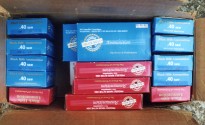 I chose Black Hills ball for the opening festivities. Commonly called ‘blue box’ ammunition, this version is available at many retailers for an attractive price. For function testing, this ammunition quickly lets you know if your gun is going to work and removes the question of ammunition quality from the equation. I also resolved to fire a number of expanding bullet loads, and settled upon the ‘red box’ Black Hills label, using the Gold Dot bullets. To broaden the test schedule, I also fired a number of extra power loads finally an example of a proven handload in each. If a handgun will not digest handloads it is not economical for my use.
I chose Black Hills ball for the opening festivities. Commonly called ‘blue box’ ammunition, this version is available at many retailers for an attractive price. For function testing, this ammunition quickly lets you know if your gun is going to work and removes the question of ammunition quality from the equation. I also resolved to fire a number of expanding bullet loads, and settled upon the ‘red box’ Black Hills label, using the Gold Dot bullets. To broaden the test schedule, I also fired a number of extra power loads finally an example of a proven handload in each. If a handgun will not digest handloads it is not economical for my use.
Rather than fire one gun in the complete program then the other, I elected to fire them side by side. I would make a run with the Springfield then with the XD 40, alternately warming up with one then the other, and note the differences in handling, speed and accuracy as I performed each test. Scientific? Perhaps not. Valid? I believe so.
 First, I field stripped each handgun and lubricated the long bearing surfaces. This is SOP with any new handgun. I noted that either came liberally lubricated from the factory, so my first step was unnecessary. The XD 40 is less complex to field strip. Simply remove the magazine and lock the slide to the rear, using the slide stop. Then rotate the take down lever located on the left side upwards. Release the slide lock and the slide moves forward off the frame. The recoil spring guide and spring are lifted out, followed by the barrel. This is simplicity itself.
First, I field stripped each handgun and lubricated the long bearing surfaces. This is SOP with any new handgun. I noted that either came liberally lubricated from the factory, so my first step was unnecessary. The XD 40 is less complex to field strip. Simply remove the magazine and lock the slide to the rear, using the slide stop. Then rotate the take down lever located on the left side upwards. Release the slide lock and the slide moves forward off the frame. The recoil spring guide and spring are lifted out, followed by the barrel. This is simplicity itself.
The 1911A1 is more difficult to field strip. The pistol is cleared of both ammunition and the magazine, then cocked and locked. The barrel bushing is rotated to one side and locked, allowing the recoil spring plunger to be removed. Then, the slide is locked to the rear and the slide stop is lined up with the witness hole in the slide and pressed out. Then the slide is pressed forward off the frame rails. The 1911A1 used in this test program was remarkably tight in slight to frame fit and proved more accurate than a similar Mil Spec in stainless steel I tested a few weeks ago. That is simply the luck of the cards, 1911s are individuals and some are tighter than others. After the slide is pressed forward, the recoil spring and guide are lifted away and after readjustment of the barrel bushing, the barrel may be moved forward.
The 1911A1 is more difficult to field strip, the field strip is more time consuming. We are looking at handguns separated by ninety years in design and execution and it shows. In lubrication requirements, the 1911A1 probably needs more frequent cleaning and lubrication but the XD 40 does not have a track record as such to study. What we do know about the pistol is good. Reassembly is in the reverse of the above directions and again the XD 40 was much simpler to reassemble. Each was given liberal lubrication as they would be subjected to a thorough range test program. Remember, a light lubrication is fine for carry, as we may fire only a few shots in an encounter and excess oil runs off in any case. But when the object is to fire hundreds of rounds, be certain the pistol is prepped.
The next step was to evaluate trigger action. The 1911 features a straight to the rear single action trigger compression. Our Springfield broke cleanly at five pounds. The XD 40 is a double action only that behaves much like a single action. It is set by the slide’s recoil. Of the various types we have tested, the XD 40 is superior to the Glock and leagues ahead of the SIGMA. The trigger broke cleanly at 6.5 pounds but feels lighter than the RCBS trigger gauge registers. Reset is not as quick as the 1911, but the trigger is controllable. With sufficient acclimation we felt a good shooter could use either trigger adequately for personal defense.
The sights were another matter. The XD 40 features bold high visibility sights that offer an excellent sight picture. In contrast the Springfield 1911A1 is strapped with small GI type sights that are difficult to pick up quickly. A comparison could have been made to the Loaded Model, which features Novak high visibility sights, but the Loaded Model cost a bit more than the 1911A1. We let the sights of the GI type pistol stand on their own merits. In short the trigger action of the 1911 is lighter and crisper, with a more rapid reset while the XD 40 has superior sights.
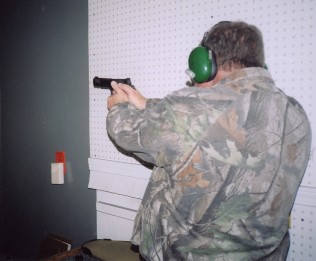 Moving to combat firing, we placed Law Enforcement Incorporated silhouette targets at seven yards and topped each magazine off with Black Hills ammunition. We began with the handgun in front of us, held in both hands, in the ready position. The 1911 was cocked and locked; the XD 40 was ready with the finger off the trigger. On a whistle, we brought the pistols to eye level and fired a magazine (seven rounds each, since the 1911 uses a seven round magazine versus the 12 round magazine of the XD 40.) at each target in turn. The 1911A1 came on target quickly, and control is excellent. Muzzle flip is limited by the pistol’s low bore axis. The shorter XD 40 showed more muzzle flip, but also showed good control. The XD 40 frame is subtly different than many polymer frame guns, including the Glock, and this improved grip angle allows better comfort, improved control, and more control of the handgun in rapid fire. Overall, the 1911A1 has an edge in this type of shooting, but a small one. The .45 kicks more than the .40, which has to be factored in. With like calibers the 1911 would have been even more controllable. On the other hand, the XD 40 is a lighter more compact handgun than the 1911.
Moving to combat firing, we placed Law Enforcement Incorporated silhouette targets at seven yards and topped each magazine off with Black Hills ammunition. We began with the handgun in front of us, held in both hands, in the ready position. The 1911 was cocked and locked; the XD 40 was ready with the finger off the trigger. On a whistle, we brought the pistols to eye level and fired a magazine (seven rounds each, since the 1911 uses a seven round magazine versus the 12 round magazine of the XD 40.) at each target in turn. The 1911A1 came on target quickly, and control is excellent. Muzzle flip is limited by the pistol’s low bore axis. The shorter XD 40 showed more muzzle flip, but also showed good control. The XD 40 frame is subtly different than many polymer frame guns, including the Glock, and this improved grip angle allows better comfort, improved control, and more control of the handgun in rapid fire. Overall, the 1911A1 has an edge in this type of shooting, but a small one. The .45 kicks more than the .40, which has to be factored in. With like calibers the 1911 would have been even more controllable. On the other hand, the XD 40 is a lighter more compact handgun than the 1911.
When limiting ourselves to one shot from ready at maximum speed the 1911 maintained a lead in accuracy. Speed to an accurate first shot does favor the 1911. But the XD 40 is no second class handgun by any means. As we moved to ten and fifteen yards the superior balance and low bore axis of the 1911A1 gave a more pronounced lead, but the XD 40 proved to be a good performer. Putting the test in perspective, I never fired a Glock, SIG, or Walther that performed as well as the XD40. The 1911 is fast, the XD 40 is good but not as fast. The ergonomics of either handgun are good. We never failed to properly actuate the grip safety of either handgun and found the pistols comfortable to fire. The .45 proved a bit more tiring due to the increased recoil of the cartridge, but this is simply logic.
In maximum speed drills and in rapidly engaging targets, then, the 1911A1 proved the superior handgun. But we moved to another test, engaging small targets at moderate range. We placed a target representing a foot or an elbow behind the target frame, simulating a felon behind cover, and attempted to engage the target with either handgun. Here, the small sights of the 1911A1 hampered some of us, and the results were even. No clear advantage was shown but the XD 40 held it’s own.
After a suitable break and rubbing of our wrists, we elected to fire the pistols for accuracy. We had on hand in addition to the jacket hollow point loads the 165 grain EXTRA POWER .40, a fine accurate load that equals the lighter 155 grain JHP in velocity. We also had on hand not only 185 grain JHP loads but the 230 grain JHP +P, a barnstorming load that jolts a 230 grain JHP to 950 fps. These loads are proven in hard use across the country. The 165 grain .40 caliber load is an overlooked loading that gives excellent performance and good accuracy. The 230 grain Black Hills .45 is among my favorite personal defense loadings, breaking 880 fps in the Springfield. The 185 grain JHP at over 1,000 fps is pleasant and mild to use yet offers good performance. The .45 is a cartridge I have extensive experience with and these are among my top choices in serious use loadings. I would be comfortable with either of the three .45 caliber JHPs or the two .40s for personal defense.
I chose to fire the pistols from a solid barricade, rather than a bench rest. This gives us a closer contract with reality. I fired three five shot groups with each load and took the average. The results are posted. At this point I confirmed the pistol’s viability with hand loads. I used the Speer Gold Dot 230 grain JHP over enough Alliant Unique break 790 fps in the .45. In the .40, I used the hard cast Magnus bullet in 140 grain weight also over Unique, at 950 fps. All loads were put up on RCBS loading dies.
|
Ammo |
|
5 Shot |
|
|
Grains |
Type |
||
|
1911A1 .45 ACP |
|||
|
Black Hills |
230 |
Ball |
4.5″ |
|
Black Hills |
230 |
JHP |
3.5″ |
|
Black Hills (+P) |
230 |
JHP |
2.5″ |
|
Black Hills |
185 |
JHP |
2.7″ |
|
Speer/Unique** |
230 |
JHP |
3.2″ |
|
XD 40 .40 S&W |
|||
|
Black Hills |
180 |
Ball |
2.9 |
|
Black Hills |
155 |
JHP |
3.5 |
|
Black Hills (EXP) |
165 |
JHP |
2.5 |
|
Magnus/Unique** |
140 |
FPBB |
2.5 |
|
* |
|||
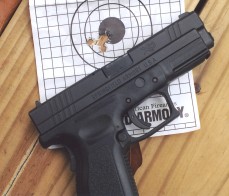 The XD 40 showed a well defined advantage in absolute accuracy in barricade fire, and this in the hands of a shooter with over 60,000 rounds fired in the 1911 pistol. The sights were part of this but the trigger is quite controllable once we become used to the cadence. Overall, the XD 40 gave excellent results.
The XD 40 showed a well defined advantage in absolute accuracy in barricade fire, and this in the hands of a shooter with over 60,000 rounds fired in the 1911 pistol. The sights were part of this but the trigger is quite controllable once we become used to the cadence. Overall, the XD 40 gave excellent results.
As for malfunctions, the 1911A1 suffered three stoppages. Slight they were, but they stopped the gun from firing, reliability being a propensity of the handgun to fire with each pull of the trigger. Three times during the first fifty rounds of ball we had to shove the slide forward in battery as the slide did not completely close. This is normal in the course of breaking in a 1911 pistol. The XD 40 came out of the box shooting and continued to do so. I have learned to keep a firm grip on polymer frame pistols to prevent a short cycle, but then I firmly grasp the 1911 to control recoil. Both handguns demand a steady hand.
In rapid reloading drills, the pistols are equal. The magazine release button of the 1911 is a bit easier to hit quickly but the large open magazine funnel of the XD 40 allows more rapid insertion of the double column magazine. The slide lock of the XD 40 requires a little more stretch of the finger but the 1911A1, while more accessible, is smaller. Again, equality.
As for safety features, I strongly prefer a handgun with a safety. The slide lock safety and grip safety of the 1911A1 are far more attractive to this shooter than any double action only pistol with no safety. The grip safety of the XD 40 makes it a far better choice than the Glock pistol but does not allow it to equal the 1911A1. This is personal preference but a strong one. I would not hesitate to carry the XD but it would have to be carried in a good holster with a covered trigger guard.
As for magazine capacity, the 1911A1 can carry either seven or eight rounds with a flush fit magazine. The XD 40 carries ten rounds in most of the available magazines but twelve round magazines will be available soon. We have nine rounds of .45 versus thirteen of .40. With faith in the .40- and generally it is a good performer- this is a considerable advantage. I could debate this subject at length, but the .45 does not rely upon trick bullets for effectiveness. Frontal diameter and bullet weight do the business. This is a proven cartridge and a generally accurate cartridge that operates at lower pressure than the .40. Weapons wear should be less. The .40 is a good defense cartridge. With full metal jacket bullets it offers considerable penetration against light cover, outpacing both the 9mm and the .45. If the comparison were the 9mm versus the .45 there would be little ground for comparison. The .40 makes the grade as a defensive handgun cartridge.
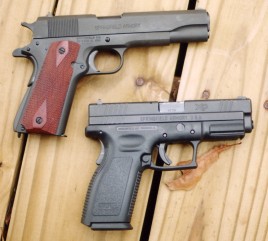 The XD 40 is a simpler handgun to fieldstrip, operate and maintain than the 1911. The manual of arms is simple- load and holster. The 1911 requires the pistol be loaded and made safe before holstering, and administrative handling is more complicated. But it is a 1911 and the advantages of the design show in combat firing. Then, we have the awful efficiency of the .45 caliber cartridge, proven in combat many times over. The 1911A1 is far more versatile, with the advantages of readily available .22 caliber conversion units and a veritable treasure trove of upgrades readily available. The XD 40 is what you see is what you get. The 1911A1 can be upgraded by a competent gunsmith. Each handgun fired well over 300 rounds of ammunition without a significant problem. The combination of features of either handgun is well worth the modest price. You will have to spend quite a bit of money to realize a significant improvement over either. The verdict? The 1911A1 remains a viable, effective defensive handgun. The XD 40 is a good handgun as well, simply different. Neither would limit the man or woman who chooses one or the other as their personal defense handgun. Both are better choices than ninety per cent of what I see in police holsters. To each his own, it is your hide. I am thankful we have such good pistols.
The XD 40 is a simpler handgun to fieldstrip, operate and maintain than the 1911. The manual of arms is simple- load and holster. The 1911 requires the pistol be loaded and made safe before holstering, and administrative handling is more complicated. But it is a 1911 and the advantages of the design show in combat firing. Then, we have the awful efficiency of the .45 caliber cartridge, proven in combat many times over. The 1911A1 is far more versatile, with the advantages of readily available .22 caliber conversion units and a veritable treasure trove of upgrades readily available. The XD 40 is what you see is what you get. The 1911A1 can be upgraded by a competent gunsmith. Each handgun fired well over 300 rounds of ammunition without a significant problem. The combination of features of either handgun is well worth the modest price. You will have to spend quite a bit of money to realize a significant improvement over either. The verdict? The 1911A1 remains a viable, effective defensive handgun. The XD 40 is a good handgun as well, simply different. Neither would limit the man or woman who chooses one or the other as their personal defense handgun. Both are better choices than ninety per cent of what I see in police holsters. To each his own, it is your hide. I am thankful we have such good pistols.
R.K. Campbell
The story, “Springfield takes on Springfield. And The Winner Is…” and supporting photos are the work of R. K. Campbell and published on RealGuns with his permission. Mr. Campbell is a writer in the firearms and outdoors field with over 500 published articles columns and reviews. He is the author of Holsters For Combat And Concealed Carry, The 1911 Semi Automatic Pistol, and the Handgun in Personal Defense. He is a contributing Editor at Women and Guns and Gun Week and Executive Editor of Boar Hunter Magazine.

Email Notification